I am in Beatty Nevada, doing an artist’s Workspace Residency at the Goldwell Open Air Museum.
It is currently day 4 of the residency and, frankly, I’m still trying to sort myself — and my environs — out.
Our residential quarters are quite wonderful — a little strange, but all mod cons including high speed internet.
The studio space is 4 miles away, at the Red Barn, donated to the Goldwell Foundation by the Barrick Gold mining company who mined the Barrick Bullfrog Mine, which has stripped the mountain to the east, creating a south-facing pyramidal mountain that I still haven’t gotten my camera around.
Here’s the Red Barn:
The photo was taken from Rhyolite, a ghost town within walking distance to the north of the Red Barn. The setting, as you see, strikes a bit of awe, maybe even fear, into the plein air artist.
Between the Red Barn and Rhyolite (a worthy topic in itself) is the Goldwell Open Air Museum. It consists of one boarded up shack with a stack of visitor’s guide in a box and a bunch of scultures, sitting unlabeled, unheralded, in the rubble-strewn, ghost-town desert.
The miner with his pickaxe looks to me a bit like Old Man Death in a miner’s hat. The shack is hiding the penguin who follows the miner. The art is “Tribute to Shorty Harris (1994) by Fred Bervoets. Shorty Harris was a legend in Rhyolite and so the sculptor gave him a penguin (out of site behind the building) to keep him company. Also the penguin is an attempt “to reflect the optimism of the mining endeavor” ( quote from the Visitor Guide). According to Richard Stephens, a Goldwell Board member, the sculptor felt somewhat out of place in the desert, so the penguin is triply appropriate.
The Lady Desert: the Venus of Nevada (1992) by Hugo Heyrman is done with cinderblocks to imitate the pixels the artist uses in his virtual computer work. In the background is Sit Here, a couch rescued from a Children’s Museum in Las Vegas and “lovingly restored and envisioned at Goldwell in 2007.”
The Ghost Rider (1984) was constructed by Albert Szukalski out of plaster-infused burlap, draped over a live figure until it set. Szukalski, well-known in Antwerp, Belgium where he originated, did a large set of figures (shown below) that he built and unveiled at Rhyolite. Those groups were first installed in the Bonanza Hills, which subsequently toppled, either through a storm or by humans. So it was moved down the hill to the Open Air Museum site, and other Belgium artists made these additional pieces that became part of the space.
Icara, by Dre Peeters, “represents a female counterpoint to the Greek myth of Icarus.” It stands at the top of two utility poles. Far below is a wagon half-buried in the dirt, origin unknown.
The Last Supper (1984) (by Szukalski) was constructed because the Mojave Desert seemed to resemble the deserts of the Middle East. Szukalski originally wanted to site the Last Supper in Death Valley (the Park boundary is about 8 miles away). The sculptures are quite large when seen close-up, but they are dwarfed by the landscape into which they are set.
Szukalski died in 2000 and the Goldwell Open Air Museum nonprofit was formed to care for his work. The Museum operates the Red Barn, where printmaking and painting studios exist (that’s my space) for the next 6 weeks), and an occasional exhibit is open to the public.
I have been reading Erin Hogan’s Spiral Jetta: A Road Trip Through the Land Art of the American West. In Spiral Jetta, Hogan talks about various “land” artists, like Robert Smithson and Michael Heizer and their attempts to deal with scale, size, and time, particularly time, with its inevitable changes. I’m thinking that the Goldwell sculptures fit into Hogan’s contemplations. They are minute in the scale of their environment, like abandoned toys in a field.
They are also, however, very much of the observed environment, a place where, when you walk, you find that humans have left bits of themselves everywhere — rusting cans, glass (something about glass that has to be broken), pipes, wires, remains of telephone poles, old rail beds, hills pocketed with mining entrances and debris of mining tailings. These elements have worked themselves into the soil and so from a distance, in a car for example, the desert looks empty of human artifacts. Empty, except for these seemingly minute ghostly white forms and the pink Venus and the poles with glinting materials.
Rhyolite, Goldwell, the Bond heap leach mine, and Beatty itself, with its casino and trailers and sometimes surfacing, sometimes hiding, Amargosa River — all are turned to trash by the desert’s cold eye. The artwork isn’t that much different.
I’m sure to be regaling you with tales of paintings done and undone, of tragedies of terre verte and chasing hats yanked away by the desert wind. But yesterday, I walked the Goldwell acres, saw 3 kinds of cactus and a lot of scrub, traversed millions of rock chunks, and paid tribute to the sculptures at the Museum. So I’m sharing this day with you.
Thanks to Richard Stephens, who helped me correct a few errors and who has promised he’ll tell us of anything else that I’ve gotten wrong.
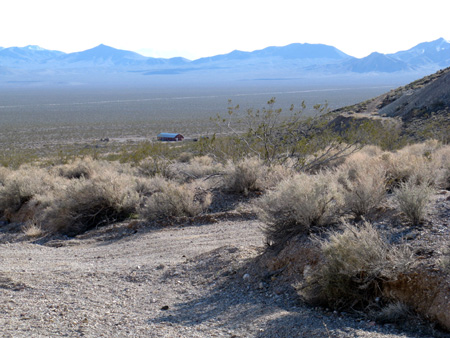
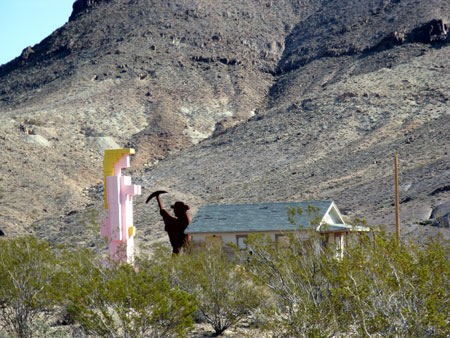
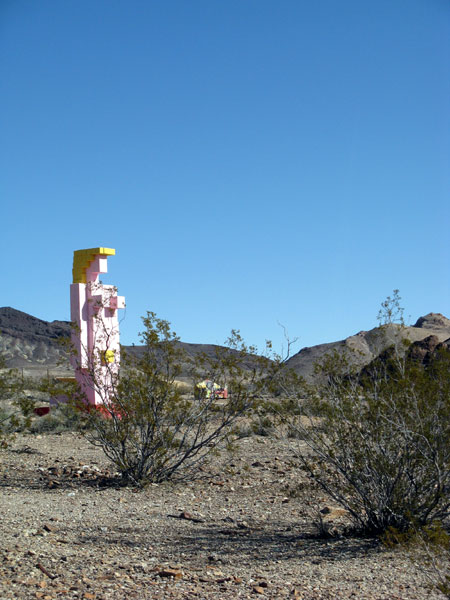

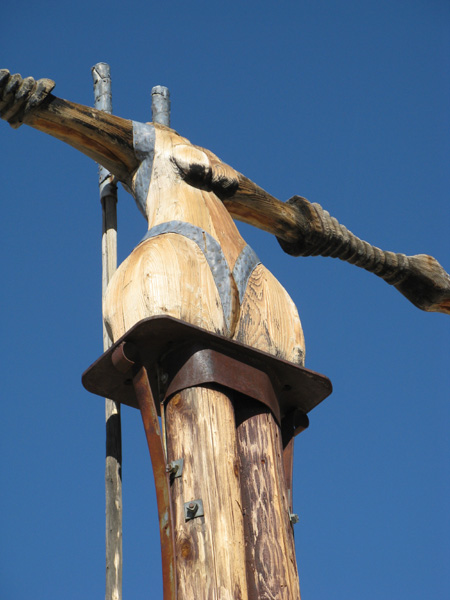

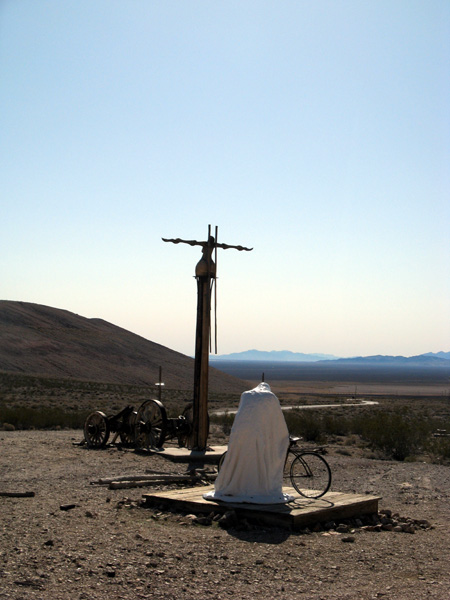


June:
What a place! Just how many of these nonprofit entities are there out there?
You did a little misspelling that I am sure is one of those Freudian slips. You refer to “sculture” and I can easily imagine it: a gaunt, rusting contraption, fashioned from discarded mining stuff found lying about and poised over the leaching operation, anticipating a long drink of the metal-laden effluent. Or am I embellishing on something that you meant and I misconstrued?
Jay,
Only one misspelling — amazing. I’m working in and around Jer on this computer — he’s happy with 15 minutes a day, but when I shove it to 17.5, he starts to pace (I exaggerate, but only a little). So producing an A&P is something of a miracle.
On the other hand, I have nothing to distract me from painting — except for the local characters who realize I’m a good ear for their oft-told tales. I have one commission for a portrait — and if I’m unwilling to do that, he’d be happy with a coiled rattlesnake. We’ll see.
I painted in town today because we have house chores — a workshop over the weekend will bring a few people into our living quarters, so laundry is on the list, etc. This means I got to meet the local realtor, also. And so it goes. Give me two weeks and I’ll know everyone in town who has a tale to tell.
I’ll try to fix sculture — although I think I could have shown you the fallen “Desert Flower” — welded out of metal car parts, I believe. It fell over in a storm. So maybe that’s the sculture you are dreaming of.
I have to say that Jer’s comment was that this was just the place you needed to come to — it’s your kind of space and vision. In the meantime, I’m painting mountains and the local “Exchange Club qua hardware store.”
June:
Is that a universal “you”, or is Jer speaking of me? I am a desert lover, perhaps because I am almost never there. Sunset is the best time.
Jay,
Jer was speaking specifically of you, Jay, because the Open Air Museum’s modus operandi seems to be to find materials hanging about in the desert and make things out of them. One piece, which seems to have been vandalized, is composed of concrete road culverts. Desert Flower probably was bits of aluminum from around the acreage. Old utility poles (no longer in use) at the entrance have a variety of materials attached to make them bristle with “found stuff.” Even I am playing with circles of stone, marking my territory in my own way.
That Mojave is serious desert, much more so than southern Utah where I’ve done my Anasazi trips. I haven’t been there in quite a while, but I see it hasn’t changed. I trust you have a very broad hat.
The big sculptures of found materials remind me of the wooden sculptures that used to grace the Emeryville mud flats, best seen driving south toward the Bay Bridge to San Francisco (I lived in Berkeley at the time). I never worked on that scale myself, but I’m currently building shelves supported by parts of an aspen cut down a few years ago. I enjoy the challenge of working within the constraints of material not designed for the purpose. And I recently bought an assemblage of found junk, the prize work in a show that nearly sold out (prices were right: $15 and $30, depending on size).
One more correction–the Barrick Bullfrog mine did not use the heap leach method. They had large steel tanks in which the powdered ore slurry was stirred and the gold extracted. The large earth mounds across the highway were tailings ponds, which have since undergone reclamation.
Steve
Thanks for the link to those Emeryville sculptures. I’ve never seen them. There, the surrounds might be (must be?) very different and so they would take on a different kind of intensity.
I love it that you bought an assemblage of found junk for some price between 15 and 30 dollars. That makes sense to me. I took a wood cutting workshop this weekend that was being held in the Red Barn, and the instructor basically gifted me with one of her woodcuts. I was stunned by the work she could produce with line and mass — the one I bought was a desert scene better than any painting I’ve seen. My woodcuts, on the other hand, well .. less said, the better.
Richard,
Many thanks for your corrections. Part of my quest, in addition to looking in order to paint, is to look in order to understand. Keep on helping me out!
I love Nevada and you are in the gem of it all.
Enjoy your stay!
A good read on your views on the Great Depression II. I think you have something here.